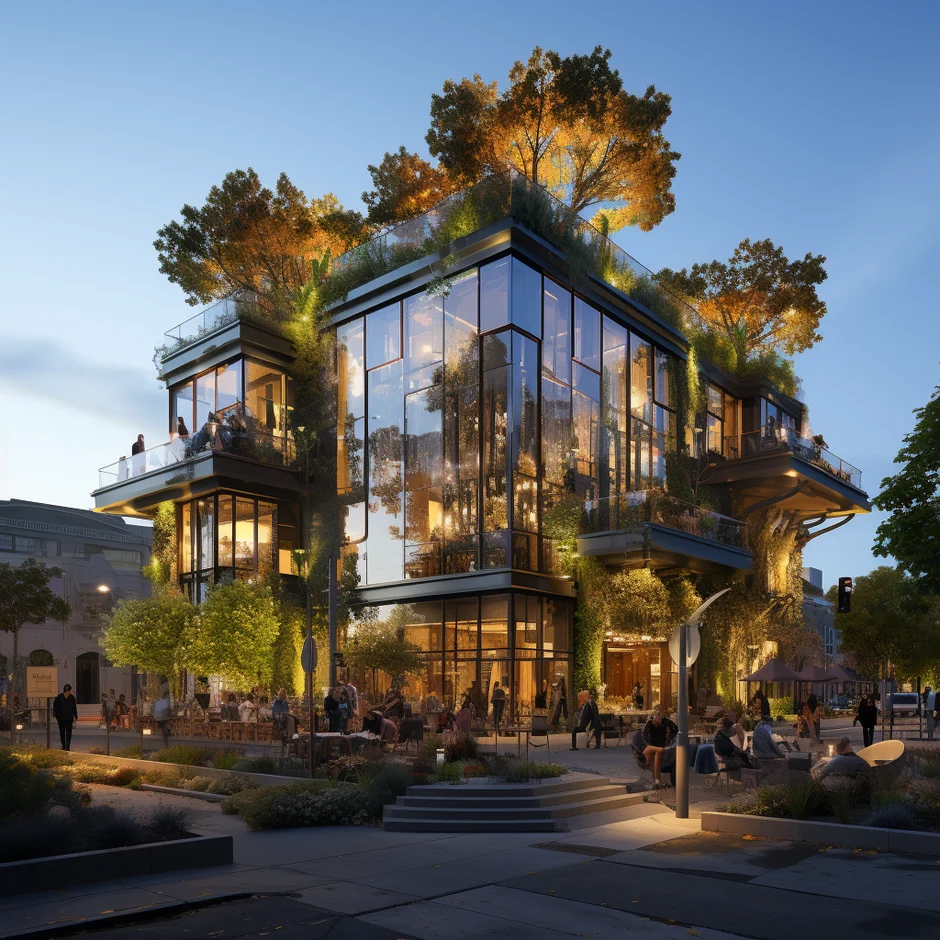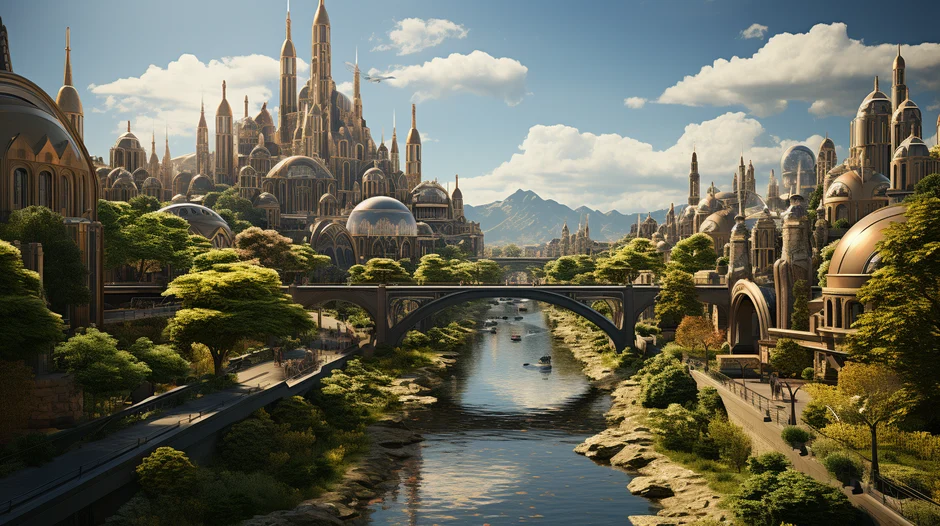Green Cities: The Revolutionary Principles of Biophilic Urban Design
Hello, architects, urban planners, and visionaries! If you have been navigating the world of architecture and urban planning, you're probably no stranger to the concept of green cities. But have you dived deep into the heart of what makes a city truly green? It's not just about slapping some solar panels on rooftops or planting a few trees and calling it a day. No, it's about fundamentally rethinking our approach to urban design. Enter the revolutionary concept of Biophilic Urban Design.
Harmony in Urban Design: Where modern architecture meets nature, showcasing the seamless integration of green roofs, living walls, and water features on a bustling city street.
Why Biophilic Urban Design?
At its core, Biophilic Urban Design is about reconnecting humans with nature within our urban environments. It's a response to the concrete jungle syndrome, where asphalt and architecture dominate, leaving little room for greenery or natural elements. This design philosophy isn't just for the aesthetics; it's about improving our quality of life, enhancing mental health, and even boosting economic value. In an era where urbanization is rapid, and disconnection from nature is all too common, Biophilic Urban Design offers a beacon of hope.
The Principles of Biophilic Urban Design
To truly harness the power of Biophilic Urban Design, we need to understand its foundational principles. These aren't just guidelines; they're the building blocks for creating spaces that resonate with our innate love for nature.
Integrating Natural Elements into Urban Spaces
One of the core principles of Biophilic Urban Design is the seamless integration of natural elements into urban spaces. This means more than just parks and green spaces (though those are crucial, too). It's about incorporating living systems into the fabric of our buildings and streetscapes. Think green roofs, vertical gardens, and water features that mimic natural streams. These elements aren't just decorative; they play a vital role in creating microclimates, improving air quality, and offering sanctuary in the bustling city.
The Foundations of Biophilic Design: An illustrative summary of integrating natural elements into urban spaces, fostering human-nature connections, and embedding sustainability into the city's DNA.
Enhancing Human-Nature Connections
Another key principle is enhancing the connection between humans and nature. This goes beyond physical presence; it's about creating environments that allow for meaningful interactions with nature. Design strategies can include maximizing natural light, ensuring views of nature from within buildings, and creating natural pathways that encourage walking and biking. The goal is to make nature an integral part of daily urban life, not just a distant concept.
Promoting Sustainability and Resilience
Sustainability is a buzzword we've all heard, but in the context of Biophilic Urban Design, it takes on a deeper meaning. It's not just about reducing energy consumption or using eco-friendly materials (though those are important aspects). It's about designing cities that are resilient and adaptable to changing climates. This means considering biodiversity, water management, and ecological systems in our urban planning. By doing so, we're not just making cities greener; we're ensuring they can thrive in the face of environmental challenges.
Implementing Biophilic Design in Urban Spaces
Creating cities that breathe, live, and connect with nature is not just a dream; it's an achievable reality. Here are some strategies to bring Biophilic Urban Design to life:
Strategic Green Space Integration
Pocket Parks and Green Corridors: Small, accessible green spaces can have a big impact. Integrating pocket parks and green corridors within urban areas provides residents with nature-filled nooks, fostering mental health and community engagement.
Rooftop Gardens: Utilizing rooftops for gardens not only adds greenery but also helps in temperature regulation and provides spaces for social interaction and biodiversity.
Building with Nature in Mind
Biophilic Architecture: Incorporating natural materials, maximizing natural light, and using nature-inspired shapes and forms can help buildings feel more connected to the natural world.
Living Walls and Vertical Forests: These not only improve air quality but also create stunning visual impacts, making nature an integral part of building facades.
Sustainable Urban Planning
Eco-Districts: Planning entire districts with sustainability and biophilic principles in mind can lead to innovative solutions in energy, water, and waste management, creating models for future development.
Green Infrastructure: Implementing green roofs, permeable pavements, and rain gardens helps manage stormwater naturally, reducing urban heat islands and increasing urban biodiversity.
A Blueprint for Urban Greening: A vibrant urban square that marries green infrastructure with community life, featuring central gardens, green roofs, and sustainable water management in a cohesive biophilic strategy.
Case Studies of Biophilic Urban Design
Worldwide Biophilic Wonders: An inspired urban scene blending Singapore's lush pathways, Milan's verdant skyscrapers, and Copenhagen's green mobility, showcasing the global impact of biophilic urban design.
Singapore — A City in a Garden
Singapore's commitment to becoming a "City in a Garden" is evident through initiatives like the Gardens by the Bay and the integration of green spaces into its urban fabric. The city-state's approach to blending urban development with greenery serves as a global benchmark.
Milan — Vertical Forests
Milan's Bosco Verticale (Vertical Forest) is a pair of residential towers adorned with nearly 900 trees and over 2,000 plants. This project not only combats air pollution but also provides a model for integrating biodiversity into urban architecture.
Copenhagen — A Green and Livable City
Copenhagen's dedication to green spaces, cycling infrastructure, and sustainable city planning has made it one of the most livable cities in the world. Its goal to become carbon-neutral by 2025 underscores its commitment to sustainable urban development.
Practical Tips for Architects and Urban Planners
Start Small: Even small projects can have a significant impact. Begin with integrating biophilic elements into existing projects or proposing small-scale green initiatives.
Community Involvement: Engage with the community to understand their needs and desires for green spaces and natural elements. This can lead to more meaningful and accepted designs.
Collaborate Across Disciplines: Work with environmental scientists, landscape architects, and sustainability experts to create comprehensive designs that address ecological, social, and economic needs.
Innovate: Use technology and innovative materials to push the boundaries of what's possible in biophilic design, from smart water management systems to air-purifying building materials.
The Future of Biophilic Urban Design: Innovations, Policies and Community Engagement
The future of Biophilic Urban Design is intrinsically linked with advancements in technology, supportive policies, and active community involvement. Smart green technologies, policy initiatives for sustainable development, and fostering community engagement and education are key to integrating nature into our urban environments.
Conclusion: Building the Green Cities of Tomorrow
Envisioning Tomorrow's Green Cities: A futuristic cityscape embracing smart green technologies, community spaces, and sustainable infrastructure under the guiding principles of Biophilic Urban Design.
The journey to creating green cities through Biophilic Urban Design is filled with opportunities and challenges. By combining innovative design principles with cutting-edge technology, supportive policies, and community engagement, we can build cities that not only thrive economically but also provide a healthy, nurturing environment for all residents. Let's embrace this challenge, crafting green cities that celebrate the connection between humans and nature.





